There are a variety of reasons why reptiles shed. The most crucial is to assist in forming new skin as they mature.
Shedding also aids in the removal of external parasites, the development of adult coloring, the conservation of nutrients, and the healing of injuries or skin injuries.
If you own a Leopard Gecko, it’s a good idea to learn how often they do this so you can take care of them how they need to be.
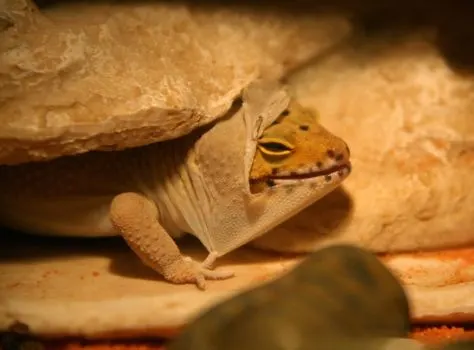 When your Leopard Gecko sheds depends on its age. When they are hatchlings and juveniles, they shed at least once or twice a month; when they are six months, they will shed once every three months.
When your Leopard Gecko sheds depends on its age. When they are hatchlings and juveniles, they shed at least once or twice a month; when they are six months, they will shed once every three months.
Once they reach adulthood, you can expect them to shed every four to eight weeks.
The frequency and ease with which your gecko sheds are determined by its age, food, and habitat.
Younger species, on the other hand, grow quicker than older individuals and hence shed more frequently. In this article, we will talk more about this subject as a whole. Let’s get started!
Shedding Behavior Of Leopard Geckos
Learning the shedding behaviors of Leopard Geckos is especially important if you’re going to take these little guys into your home.
What Causes Leopard Geckos To Shed?
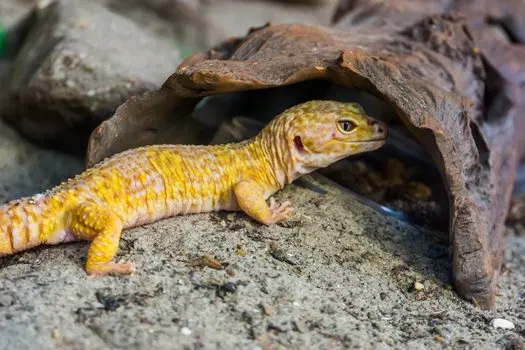 There are a variety of reasons why reptiles shed. The most crucial is to assist in forming new skin as they mature.
There are a variety of reasons why reptiles shed. The most crucial is to assist in forming new skin as they mature.
Shedding also aids in the removal of external parasites, the development of adult coloring, the conservation of nutrients, and the healing of injuries or skin injuries.
In the wild, shedding can keep parasites such as ticks and mites at bay, preventing disease. Shedding over months can also aid in the recovery of bites, scratches, and other minor injuries.
Shedding, on the other hand, is not limited to wild animals. Leopard geckos in captivity regularly shed as they mature, renew their skin cells, and change color.
They will brush against a hard item or use their lips to remove the shed skin from their body once the new layer of skin is ready and the old layer has dried off. The new skin will be colorful and vibrant.
Shedding Times For Leopard Geckos By Age
- As hatchlings and juveniles, they can shed once or twice a month.
- Once your lizard reaches the age of six months, it will shed once every three weeks.
- Geckos shed every four to eight weeks by the time they reach adulthood. Your lizard may cease shedding briefly (e.g., brumating or incubating eggs).
What Causes Leopard Geckos To Shed?
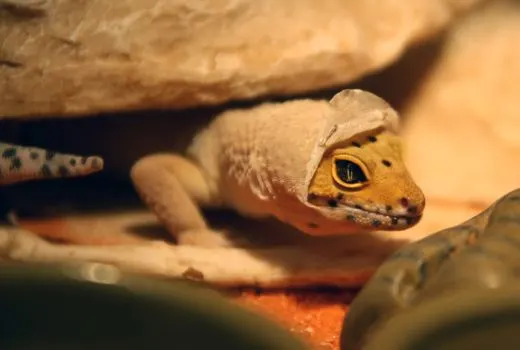 There are a variety of reasons why reptiles shed. The most crucial is to assist in forming new skin as they mature.
There are a variety of reasons why reptiles shed. The most crucial is to assist in forming new skin as they mature.
Shedding also aids in the removal of external parasites, the development of adult coloring, the conservation of nutrients, and the healing of injuries or skin injuries.
In the wild, shedding can keep parasites such as ticks and mites at bay, preventing disease. Shedding over months can also aid in the recovery of bites, scratches, and other minor injuries.
How Long Does It Take Leopard Geckos To Shed?
A leopard gecko’s existence is filled with shedding. For a healthy lizard, the process is simple and quick.
It usually takes one to three days for your pet to shed when you detect it is commencing a shedding cycle (i.e., its skin becomes dull).
However, after it begins to shed, the skin-shedding process takes around an hour, but some geckos may take up to 24 hours. During the shed cycle, your leopard gecko may decrease its appetite. This is very normal.
They use a lot of energy to grow new skin and shed old skin. It’s natural for your leopard gecko to become sluggish and tired when the two skin layers begin to separate.
This isn’t a concern as long as your lizard’s energy levels return to normal after shedding.
When To Know It’s Other Health Issues
Even three days after their shed, pets who are still sluggish could be suffering from another health issue. If your leopard gecko is hungry in the days preceding shedding, you can feed it.
However, if it begins to shed, wait until it is finished before providing more food.
They are vulnerable to predators due to the process of removing old skin. Handling or introducing food to a reptile in the middle of a shed can cause shedding issues.
Even on good days, they will be cranky. While your lizard sheds, it’s best to let it alone in its tank.
What’s The Deal With My Leopard Gecko Not Shedding?
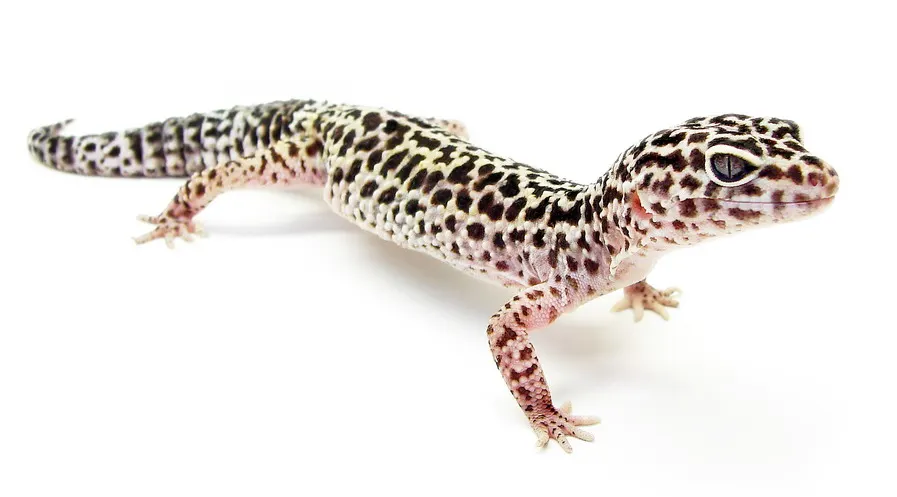 Leopard geckos may shed less regularly as they grow older. You might not see your lizard shedding at all, especially at night.
Leopard geckos may shed less regularly as they grow older. You might not see your lizard shedding at all, especially at night.
This can make it appear as if your leopard gecko isn’t shedding when, in fact, it is.
Your lizard is still shedding if it is otherwise healthy, growing, and feeding; you may be missing the shedding season.
It’s natural for your leopard gecko to become sluggish and tired when the two skin layers begin to separate. This isn’t a concern as long as your lizard’s energy levels return to normal after shedding.
Even three days after their shed, pets who are still sluggish could be suffering from another health issue. If your leopard gecko is hungry in the days preceding shedding, you can feed it.
However, if it begins to shed, wait until it is finished before providing more food.
Set Up The Correct Cage For Your Leopard Gecko
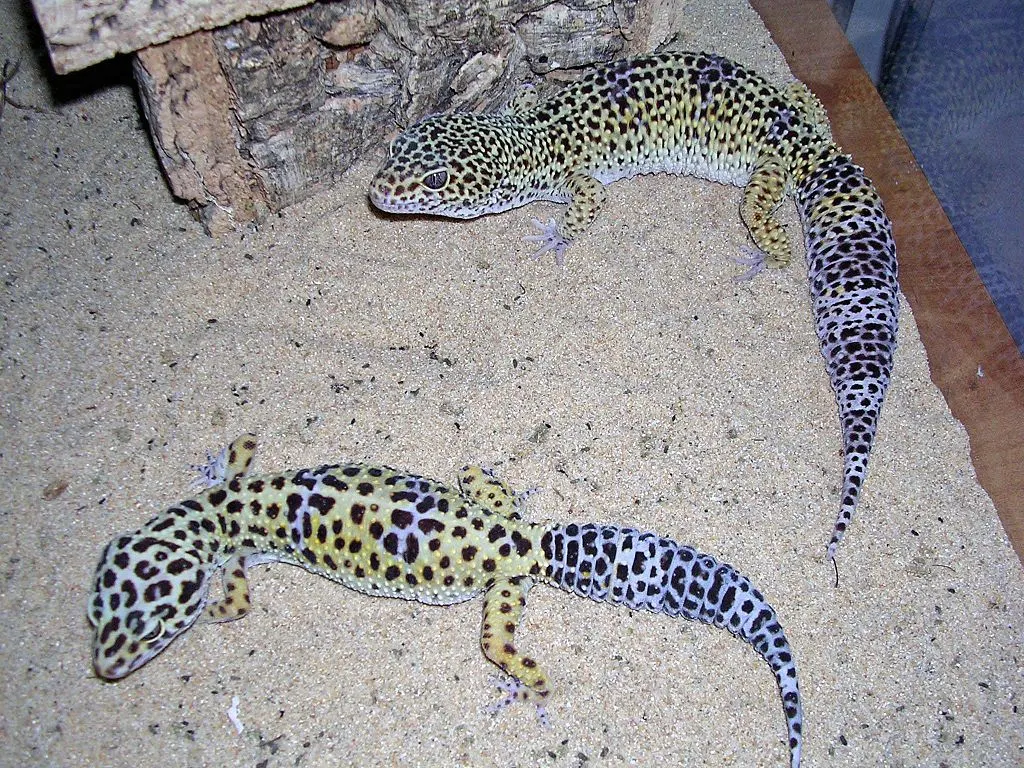 Setting up the correct cage is the finest thing you can do to assist your leopard gecko in successfully shedding.
Setting up the correct cage is the finest thing you can do to assist your leopard gecko in successfully shedding.
If your leopard gecko’s habitat and nutrition are appropriate, they should shed easily. In general, you should avoid attempting to remove a jammed shed by yourself.
The delicate skin beneath the shed can be damaged if pulled off. Soaking, misting, and bathing your lizard will make it easier to shed.
How To Make Sure Your Gecko Sheds Easily
Here are our top three suggestions for ensuring that your Gecko sheds easily.
Environment
The right temperature, décor, and humidity are critical for shedding health. Leopard geckos are arid lizards that like to live in arid environments.
As a result, some new owners are unaware that this species still requires a high-humidity environment to shed adequately.
For leopard gecko shedding, a humidity level of 40% is ideal; however, too much or too little humidity can cause issues. Do not allow the moisture to fall below 30%.
Low humidity dries down the previous skin layer, making peeling it away considerably more difficult.
Provide A Shed Box
Providing a shed box or hide made of coconut fiber or sphagnum moss that stays damp in the tank is a terrific idea.
The hide should be damp enough to generate condensation on the sides but not so wet that water drips down the walls or from the top.
The Decor Matters
You should also provide rough décor for your Gecko to rub against during shedding. This could be anything from a plastic hide’s edge to sticks, rocks, or branches.
These surfaces should be abrasive enough to release shed skin but not so harshly that your Gecko is harmed.
When your Leopard Gecko sheds depends on its age. When they are hatchlings and juveniles, they shed at least once or twice a month; when they are six months, they will shed once every three months.
Once they reach adulthood, you can expect them to shed every four to eight weeks.
Pay Attention To Eating Habits
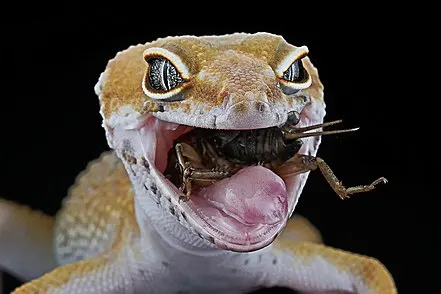 A healthy diet can help you avoid not only shedding problems but also a variety of other health issues.
A healthy diet can help you avoid not only shedding problems but also a variety of other health issues.
Leopard geckos, unlike some lizards like the blue-tongued skink, are insectivores. To keep healthy and happy, they require an all-insect diet.
Vitamin A deficiency, which can be induced by eating improper food, is a dietary cause of irregular shedding.
Crickets, Dubai cockroaches, mealworms, and super worms should be fed to leopard geckos. A vitamin powder supplement should be applied to insects.
Lighting Matters
It is a frequent myth that leopard geckos do not require specific lighting because they are nocturnal.
Because they are most active at dawn and dusk, this species is exposed to sunlight in the wild. They require UVB light as pets. This aids in the conversion of calcium to vitamin D.
The presence of UVB aids your lizard’s shedding process. It also aids in the complete digestion of food and avoiding vitamin shortages.
Keepers usually don’t have to be concerned with shedding. Leaving your lizard alone while it sheds is the best thing you can do for it. Only intervene when it’s apparent that your Gecko needs help shedding its skin.
Heather is an animal lover that has many of them herself. She currently has her Blue Nose Staffy named Bootsie, but she’s catered to many animals over the years including guinea pigs, alpacas, cockatiels, cockatoos, bunnies, chinchillas, hedgehogs, and more. She believes that knowledge should be the foundation of caring for any pet.

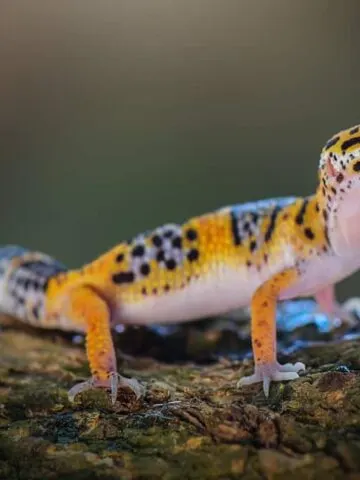

Leave a comment
You must be logged in to post a comment.